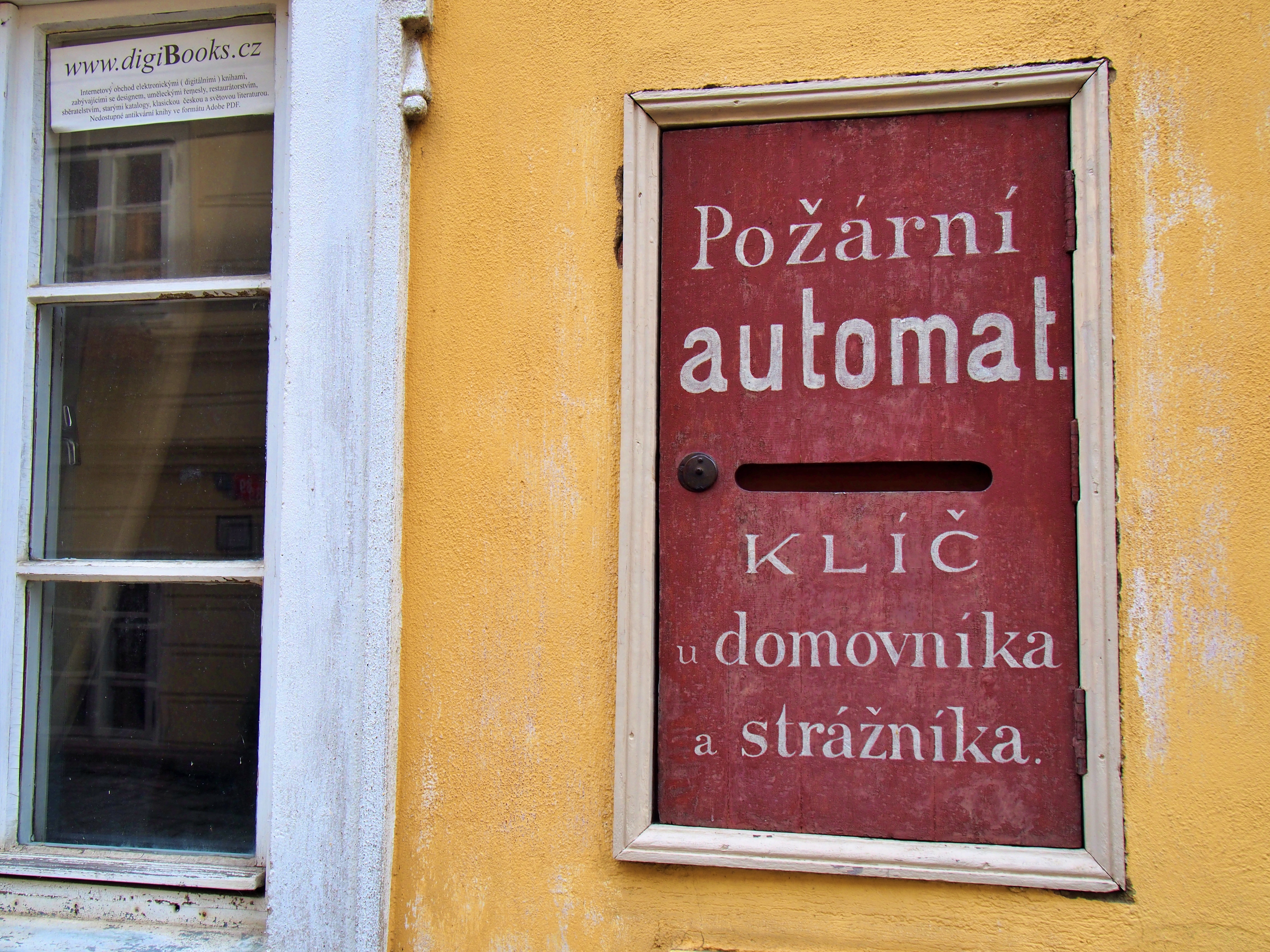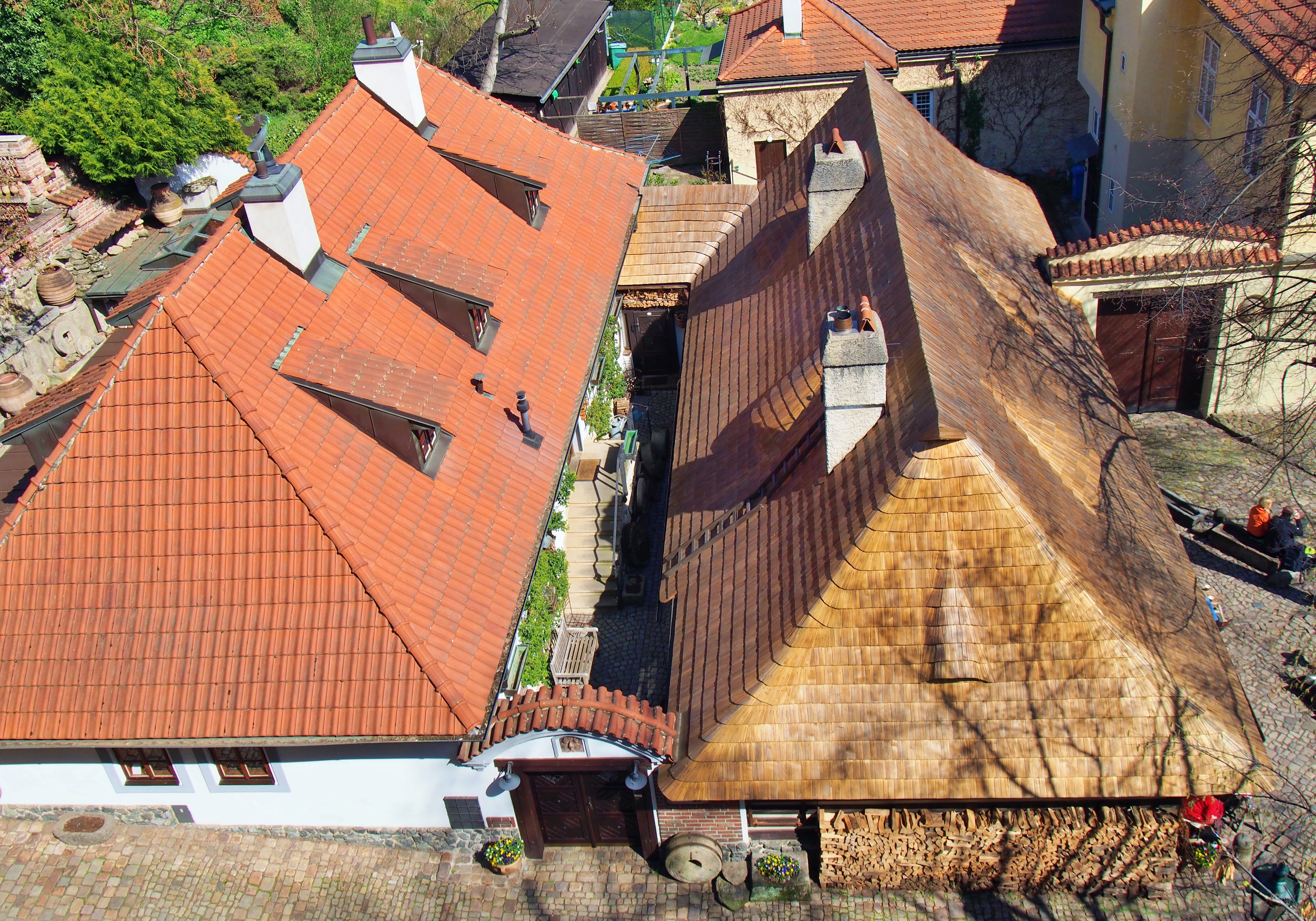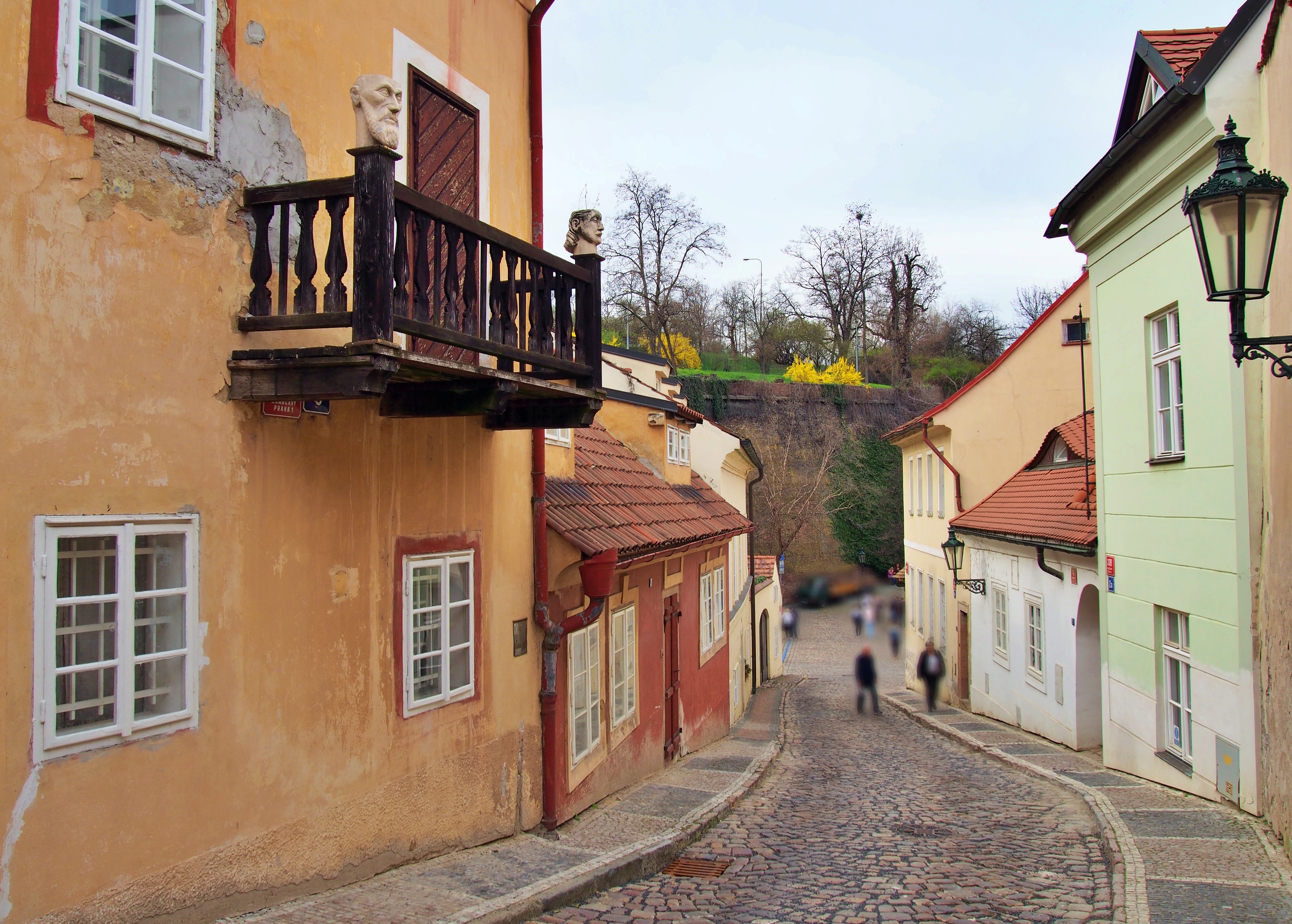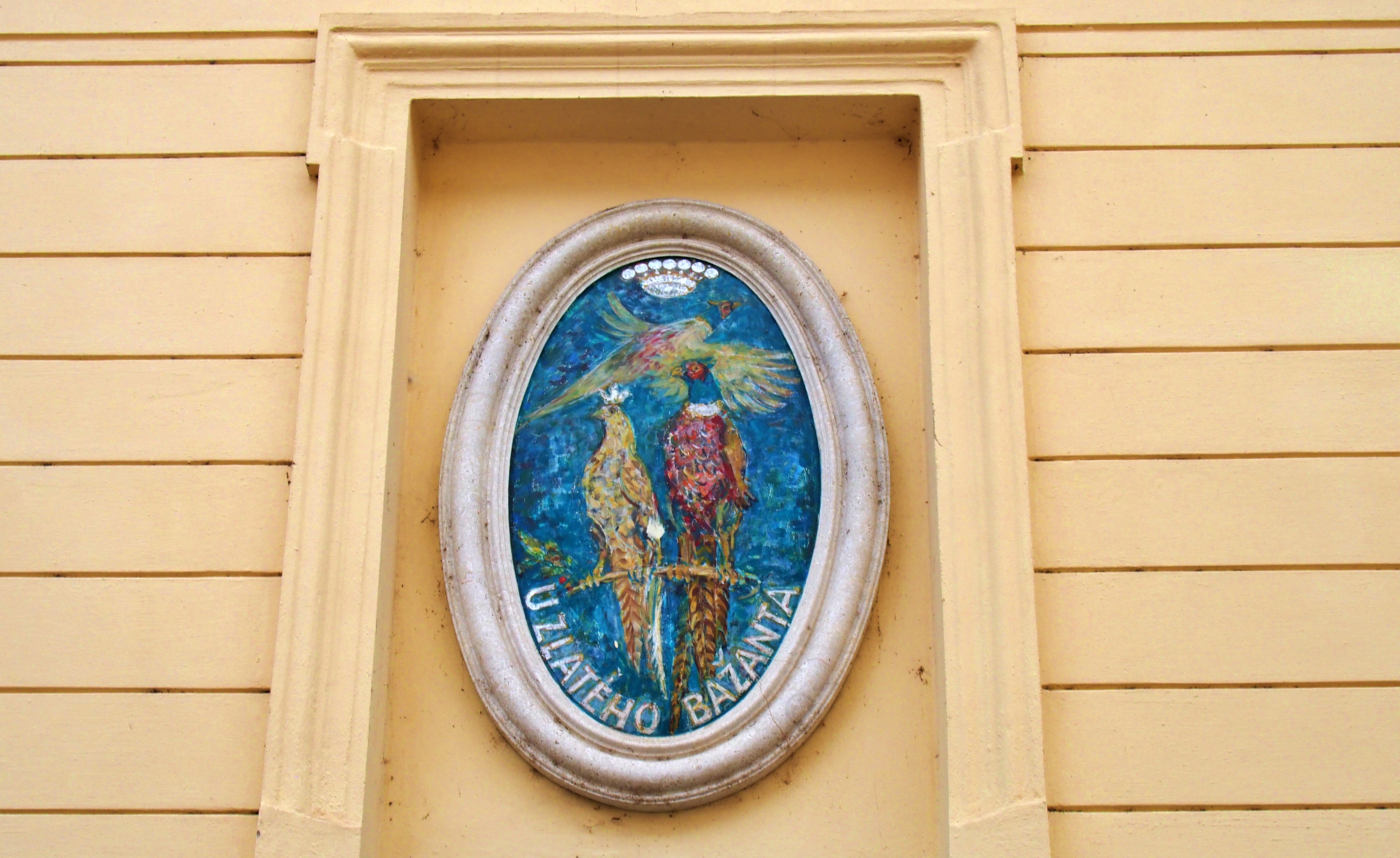
I love walking through old Prague and in fact I only recently discovered the mysterious New World (Nový Svět), which is located below Loreta. It is such a picturesque place that is hidden from the tourist traffic. It’s really beautiful, but still a bit forgotten. Of course, you will find tourists here, but there are not enough of them to disturb the special peace and charm of this place. The big change came after the revolution, when most people had to move out because the houses were returned to the original owners in restitutions. However, most of them did not have the money for the reconstruction, so they sold the houses or let them fall into disrepair. The houses are gradually being repaired here and new residents are moving here.
Picturesque houses will definitely seem familiar to you. They served as backdrops for many films. The New World was seen in the fairy tales Honza almost king and Magical Heritage, in the series The Dynasty of the Newcomers or in the films Wonderful Men with a Crank.
AND WHY THE NEW WORLD?
The massive wall of the Baroque walls reminds us that this is where historic Prague ended and the locality became known as the New World. It is no longer new, but it still remains a slightly different world.
PERIPHERY UNDER THE CASTLE
This periphery below the Castle was originally a district of servants. The castle servants lived here, but also the poor. It will be clear to you during the walk that life in the houses was very cramped. In one small room, large families crowded here. However, they still spent most of the time outside on the street, where children were playing and women were talking or hanging clothes. Nový Svět (New World) became a part of the town of Hradčany by the decision of Emperor Charles IV. in 1360. This locality survived the Hussite wars, the great fire of Hradčany and the Lesser Town in 1541, the Thirty Years’ War, the plague epidemic and the Prussian occupation.

DURING THE FIRST REPUBLIC, THE NEW WORLD WAS CALLED THE NAPLES OF PRAGUE!
Living in the New World wasn’t that so great. The apartments here were very small, damp, musty and even moldy. Clotheslines were stretched between the houses, where the sheets were dried. So, rather than Prague, it reminded us of Naples. People had various small tables and chairs pulled up on the sidewalk and talked. In short, it lived here. And that is why this part of Prague was called the Naples of Prague.
IN GOOD COMPANY
After World War II, the place inspired and became the home of many artists. Writers, painters and filmmakers lived side by side. They were mostly of an alternative type, so they found asylum here before the regime.
NEW WORLD STREET
New World Street copies the original road along the Brusnice stream, which in these places led to the settlement of Střešovice. The main street gave the name to the whole neighborhood. This also includes Černínská, Na Náspu, Kanovnická and Kapucínská streets. You may find this name confusing, but the purpose was to distinguish this district from the lavish Hradčany.

If I counted correctly, you will find twenty-five houses here. Poor people lived in the neighborhood, but you wouldn’t know it by the flashy names of the local houses. It is even said that New World is the goldenest in all of Prague. The houses were named after the relevant house signs. Gold is full of gold here. Maybe because the locals had a deep pocket, they tried to make up for their misery with the golden names of their houses. Here you will find names like At the Golden Pear, At the Golden Stork, At the Golden Star or At the Golden Bush. Another peculiarity is that until 1985, for example, the last gas lamps in Prague were lit here.

AT THE GOLDEN FOOT – House no. 1
What does it actually mean “foot”? This is definitely the question you ask yourself when naming this house. The foot is a combination of a lion and an eagle, a feathered lion or griffin. In the house during the time of Rudolf II. in 1600 it was an accommodation inn. The house is most famous for the stay of the famous Danish astronomer and alchemist Tycho Brahe, who came to Prague at the invitation of Rudolf II. Tycho described the planetary system very well, making only such a small mistake that the Earth does not orbit the Sun, but vice versa.

As I wrote earlier, the houses in New World are very small, so Tycho did not fit into the house with all his devices. And so Rudolf II. he had to move to Karz’s house in Pohořelec, which was much larger. An interesting reputation is also linked to his death, which I remember from school. It is said that his bladder burst at the feast in the presence of the emperor because he did not allow himself to leave. Tycho Brahe is buried in the Týn Church. During his exhumation in 1901, his beard and hair revealed that he might have been poisoned. His remains allegedly contained excessive amounts of mercury. However, during another exhumation carried out in 2010 at the request of the Kingdom of Denmark, their scientists found that the amount of mercury in the astronomer’s body did not exceed normal values. So it looks like we probably won’t know the truth today.


Another well-known inhabitant of the house was Jaroslav Drobný, an excellent hockey player and especially a tennis player who was born here. For example, I find it very interesting that he played under four different identities at Wimbledon. For the first time in his native Czechoslovakia, even at the age of 16. A year later, in 1939, the Protectorate presented Bohemia and Moravia. After the communist coup, he emigrated to Egypt, where he became an Egyptian citizen and won Wimbledon for Egypt in 1954. He then moved to Britain, where he married and acquired British citizenship. And so in 1960 he played for the United Kingdom.
AT THE GOLDEN PEAR – House No. 3
The house is in the style of rustic baroque. We could easily include some plant motifs in the Art Nouveau. So, with a bit of exaggeration, I would say that this is the first Art Nouveau house in Prague, and who knows, maybe even in Europe. During the First Republic, there was a “dive” of very dubious reputation – something like the legendary Poison Hut. You may know this from the television crime series The Sinful People of Prague as the “dive of the Prague gallery”.


AT THE GOLDEN GRAPE – House no. 5
I probably like this beautiful palace the most. In my opinion, it is one of the most beautiful houses in the New World. The sign on the house was a golden grape, which unfortunately has not been preserved on the house, because it was probably wooden. The people of the house sometimes mistakenly say At the dolphin, according to a two-tailed fish that adorns the lower part of the bay window facing Kapucínská Street. The fish is only a copy because the original offended the truck that drove the wine to one of the local wineries.

The house was built in 1694 by Abraham Unkoffer, a citizen of Hradčany, on the site of an earlier medieval building. When the house was being built, the Capuchins from the next monastery filed a lawsuit against it. It bothered them that from the upper windows of the house you could see them into the garden. Unkoffer therefore had the blind windows painted on the back of the house and won the dispute. The house At the Golden Grape belonged to the Unkoffer family until 1765, when it was acquired by the Voršilka sisters, who immediately sold it to art collector Josef Pikart. It was Pikart’s rich collection that became the cornerstone of the Society of Patriotic Friends of Art. Today it is the National Gallery. The last owner then donated the house to Czechoslovakia in 1918.

In the past, the pianist and composer Rudolf Friml also lived here, along with 10 other family members. He later became famous in America as the founder of musical theater. He fell in love with his sister Zdena, came here to see her and later the singer Karel Hašler married her. Who wouldn’t know his song “Ta naše písnička česká“? Half a century later, the socialist OPBH house classified the house into the fourth category and let it fall into disrepair. Jan Reich, an art photographer and representative of landscape and urban photography, moved into the house. He was one of the last classics of Czech photography, who photographed in black and white on a large-format board device. He moved into the house as part of one of the “ball lightning” events, as it was called mass exchanges of flats. The house had a sagging ceiling and a leaking roof. Even so, Reich found peace here for work and inspiration.


AT THE GOLDEN ACORN – House No. 7
The Baroque villa stands on a kind of fork at the two ends of Kapucínská Street and was built in 1707 by the famous architect Jan Blažej Santini for the family of his plasterer František Santini.

THE GOLDEN BUSH – House No. 15
The chamber house with a lantern above the entrance, called the Golden Bush in the New World, is one of the oldest surviving houses in the New World. Such houses were built in the 14th century during the reign of John of Luxembourg. After the First World War, the house was owned by the Mahler family. The Mahlers lived in mixed marriages. Mahler was a Jew and his wife a Christian. During the Protectorate, they committed suicide together by gas poisoning. During the occupation, the Germans took the house as Jewish property.

AT THE GOLDEN LAMB – House No. 19
Famous personalities rented the studio here. It was, for example, the artist and musician Milan Knížák. The rooms here were absolutely unfurnished, damp, without accessories, and he first slept dressed and wrapped in a canvas. Because the rooms were small and dark, he worked mainly outside. Thus, his work got into the public space, where he organized various artistic happenings. In 1965, he was visited by the bohemian American beatist and poet Allen Ginsberg, who was expelled from Czechoslovakia in 1965. Students elected him King Majáles in Prague and Ginsberg was detained and deported to the airport on the basis of a provocation by the State Security. They cited drunkenness or rioting, for example, as the reason.


After him, the painter Miloš Kurovský lived in the house, who had his studio on the ground floor of the house, where he exhibited and sold his paintings. Kurovsky did not get along well with the previous regime and was not allowed to exhibit in public. However, he matured to this ban and painted his creations outside the house right on the street in nice weather. He also held exuberant parties at the piano, played by his friend Laco Déczi. This American jazz trumpet player, composer and painter of Slovak origin, left Bratislava for Prague, where he emigrated in 1985.

AT THE GOLDEN TREE – House no. 13
The house housed a film screenwriter, director of the series Visitors, Mr. Tau, Octopus from the 2nd floor and Lucie, fear of the street from Jindřich Polák.


Followed by house No. 9 U Sv. Michal, opposite which are the entrances to the Stag Moat to the Brusnice stream.

The first entrance leads to the playground behind the wall and the second to the summer stage of the Ungelt Theater. The director of the Ungelt Theater, Milan Hein, even lives here.

AT THE WHITE LION – House No. 21
You will not find any lion on the facade of this house, but there is an old bicycle hanging above the entrance to the house.

If you opened this door, you would find another bicycle inside, which is much larger. Of course without shorts. 🙂 In this house today is the New World studio and is owned by Mr. Hořava, who is a member of the Czech Cycling Club. And it is on this great stage that he participates in the World Championship of Historical Bicycles.

AT THE GOLDEN PLOUGH HOUSE- No. 25
Originally, it was just a house in the simple Baroque style from the 1960s. In 1804 it was divided into two. The house housed the violinist Jan Ondříček, who gave birth to a son František, a future famous violin virtuoso. A commemorative plaque for house no. 25 also commemorates this event.




You may think that this is the narrowest house in the whole of Prague. Unfortunately, this is not the case. House No. 6 from Černínská Street stretches here. In short, the New World is known for the fact that houses here have no numbers or there are a lot of numbers.
HOUSE AT THE GOLDEN STAR
The history of the house with a small porch dates back to the 17th century, when it served as a hunting lodge. At that time, employees of Prague Castle took care of it, taking care of the field in the Stag Moat. Its administrator lived here until 1821. Since then, a butcher’s shop and a bar have changed here. The house is now inhabited by the Forman family. They organize film screenings and they have a coffee shop here, designed especially for the inhabitants of the New World.




STREET NA NÁSPU
The street is very short and leads directly to the baroque walls in Keplerova street. There is actually only one house in the whole street, number 2.
HOUSE NO. 2 IN NA NÁSPU STREET
Karel Kachyňa, the director of such films as The Sisters, The King of Šumava, Love Between Raindrops, Forbidden Dreams, Fany and many others, walk through the town. Today, a widow, actress Alena Mihulová, lives here, who says that she is even haunted in the house.

HOUSE AT CRAYFISH
Are you looking for a timbered cottage in the historical center of Prague? So I’m not. 🙂 And yet you can find it here in Černínská street 10/93 near Mariánské hradeb. Although it is not original, because it was attacked by a woodpecker and it could not be saved, but it is still an exact copy of the original log cabin with a shingle roof. And why the name At crayfish? Originally, the Brusnice stream flowed here. The water in it was so clear that crayfish lived in it. You can even find a mention of the building in the work of Jakub Arbes in the novelet The Miraculous Madonna. The author used to come here to see his future wife, the seamstress Josefina. Even this beautiful cottage replaced a number of famous tenants. In the 1950s, the log cabin was bought by the writers Arnošt Lustig and Ota Pavel. Both were linked by a long and sincere friendship that began at the end of World War II. Here they drew inspiration for their literary works.



In the one of rooms has the studio of the great photographer Ota Richter, who, among other things, captured the beginnings of the Semaphore Theater, the Na Zábradlí Theater, etc. In 1963 he emigrated to the United States. In 1987, the cottage was bought by the artist and photographer Alexandr Paul. It was he who built the replica of the original log cabins. What do you see today? Today there is a romantic accommodation.

STREET ČERNINSKÁ
This street is not for any girls in high heels. It is paved with bumpy “cat’s heads”. 🙂
HOUSE AT THE GOLDEN SUN
Probably the most famous and at the same time the most photographed object in the New World is a mysterious house without a door. It is a three-story house with number 27 on the corner of New World street and Černínská streets. The whole thing creates the illusion of a mini house without a door.

Tip for children: Try stepping out the width of the house and then do the same at home in your room. Can he imagine that a large family lived here, perhaps with ten children? So I’m not at all. 🙂
The house has only an indicated frame in the plaster and one window. The houses are connected by an internal staircase. The painted ceiling from the 17th century is from Martin’s Palace. So where do you enter the house from? Well, it was from the neighboring house No. 27. The painter Jiří Anderle stayed here, who demolished two houses so that there would be at least some space. Until now, the house was inhabited by academic painter and graphic artist Vladimír Suchánek and his wife (he died this year).

My tip: Raise your head! You will find three cannonballs on the connected house. At least that’s how he looks. And what is the truth? They were found to be kitchen ladles. They were apparently placed here with a reference to the war conflicts that were there. 🙂
HOUSE No. 6
And to make matters worse, in one place there is another house with the descriptive number 6. And why does it have the same designation? That’s because this house belongs to its own New World street. In addition to the new street sign, there is also a preserved old painted German-Czech signage from the 18th century “Neuwelt-gasse”. In translation, the name means “In the New World”. At that time, the new world was still written in small letters.

HOUSE no. 5
The house includes a statue of St. John of Nepomuk. The house is home to film director (film Little Otik) and artist Jan Švankmajer. Here he created the famous “amarouns” for the series Visitors. In the 1970s, the actor Jan Tříska visited him here before emigrating to America.

AT THE GOLDEN PHEASANT – House No. 7
The painter Jan Zrzavý lived and worked here for a while. He created five paintings here and four are in the possession of the National Gallery. Quite a bomb is his Calvary in Locronan II. sold for 17 million CZK. The last owner was film screenwriter and director Ivo Novák. For example, he directed the film Handsome Hubert. I really like his film Summer with a Cowboy.

KAPUCÍNSKÁ STREET
From Loreta, the branching Kapucínská Street slopes down to the New World. In No. 2 lies a part of the former military prison from the times of Austria-Hungary, the so-called Hradčany House. The house served first the Gestapo and then StB investigators as a torture chamber.




This building was chosen as the prison by the then Deputy Minister of Defense, General Bedřich Reicin, one of the main creators of the fabricated trials of Czechoslovak soldiers and officers. “Domeček – Hradčany House” is called the cruelest torture chamber run by the communists in Czechoslovakia.

HOW TO GET THERE?
Take the tram no. 22 to the stop Brusnice, you will see a hotel, go around that hotel to the street Jelení and then down the stairs and that is it. Very easy right? I am still surprised that even this place is not a secret, is it not discovered by tourists yet.
My tip: Head to the New World early in the morning. You will not meet anyone here and the romantic area will be yours alone.

If you ever get lost in Prague’s New World, turn left from house At he Golden foot. Opposite the entrance to the Stag Moat is the entrance to the Upper Lumbe Garden. There is peace, you can walk or sit and enjoy the view of the rooftops of the New World and also an unconventional view of Prague Castle and St. Vitus Cathedral. And because not much is known about the garden, you may be completely alone there. 🙂
I hope you enjoyed my article, and if so, I’d love for you to let others know or share it. And don’t forget to leave soon, in a moment Prague will be full of tourists again. 🙂
If you liked the article, I’ll be happy if you share it or leave some comments. 🙂 I would also want to invite you to join me on Instagram and on Facebook.







